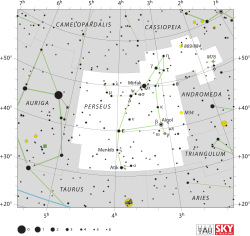|
| 32 Persei |  | Observationsdata
Epok: J2000.0 |
|---|
| Stjärnbild | Perseus |
|---|
| Rektascension | 03t 21m 26,55723s[1] |
|---|
| Deklination | +43° 19′ 46,7414″[2] |
|---|
Skenbar magnitud ( ) ) | +4,96[3], +4,94 (V)[4] |
|---|
| Stjärntyp |
|---|
| Spektraltyp | A3 V[5], |
|---|
| U–B | +0,07[6] |
|---|
| B–V | -0,051 ± 0,006[7] |
|---|
| Variabeltyp | Konstant (CST)[4] |
|---|
| Astrometri |
|---|
Radialhastighet ( ) ) | -9,00 ± 2,8[8] km/s |
|---|
| Egenrörelse (µ) | RA: -59,947 ± 0,624[1] mas/år
Dek.: -0,839 ± 0,405[1] mas/år |
|---|
Parallax ( ) ) | 21,8865 ± 0,2690[1] |
|---|
| Avstånd | 149 ± 2 lå (45,7 ± 0,6 pc) |
|---|
Absolut magnitud ( ) ) | 1,64[3] |
|---|
| Detaljer |
|---|
| Massa | 2,05[9] M☉ |
|---|
| Radie | 1,8[10] R☉ |
|---|
| Luminositet | 21[9] L☉ |
|---|
| Temperatur | 8 872[9] K |
|---|
| Metallicitet | -0,01 (Fe/H)[11] dex |
|---|
| Vinkelhastighet | 144[9] km/s |
|---|
| Ålder | 125+75-25[12] miljoner år |
|---|
| Andra beteckningar |
|---|
| GEN# +1.00020677, 2MASS J03212655+4319468, ZI 181, GSC 02873-03762, NSV 1107, TD1 2093, AG+43 365, HD 20677, PLX 696, TYC 2873-3762-1, BD+42 750, HIC 15648, PLX 696.00, UBV 3213, CSV 100266, HIP 15648, PPM 46072, UBV M 9452, FK5 2236, HR 1002, ROT 455, uvby98 100020677, GC 4004, IRAS 03180+4308, SAO 38750, WEB 3000, GCRV 1853, JP11 770, SKY# 5048, Gaia DR2 241279069280395904[2][13] |
32 Persei, som är stjärnans Flamsteed-beteckning, är en ensam stjärna[14] belägen i den mellersta delen av stjärnbilden, Perseus som också har Bayer-beteckningen I Persei. Den har en skenbar magnitud på ca 4,96[3] och är svagt synlig för blotta ögat där ljusföroreningar ej förekommer. Baserat på parallax enligt Gaia Data Release 2 på ca 21,9[1] mas, beräknas den befinna sig på ett avstånd på ca 149 ljusår (ca 46 parsek) från solen. Den rör sig närmare solen med en heliocentrisk radialhastighet av ca -9 km/s.[8] Stjärnan ingår i en samling stjärnor med gemensam egenrörelse i superhopen Sirius.[15]
Egenskaper
32 Persei är vit stjärna i huvudserien av spektralklass A3 V.[5] Den har en massa som är ca 2[9] solmassor, en radie som är ca 1,8[10] solradier och utsänder ca 21[9] gånger mera energi än solen från dess fotosfär vid en effektiv temperatur på ca 8 900 K.[9]
32 Persei misstänktes vara variabel men noggrannare mätningar har kunnat fastslå att den inte varierar i ljusstyrka.
Se även
Referenser
- Den här artikeln är helt eller delvis baserad på material från engelskspråkiga Wikipedia, 32 Persei, 31 juli 2020.
Noter
- ^ [a b c d e] Brown, A. G. A.; et al. (Gaia collaboration) (August 2018). "Gaia Data Release 2: Summary of the contents and survey properties". Astronomy & Astrophysics. 616. A1. arXiv:1804.09365. Bibcode:2018A&A...616A...1G. doi:10.1051/0004-6361/201833051. Gaia DR2 record for this source at VizieR.
- ^ [a b] ”Basic data: * l Per – High proper-motion Star” (på engelska). Centre de Données astronomiques de Strasbourg. http://simbad.u-strasbg.fr/simbad/sim-basic?Ident=32+Per&submit=SIMBAD+search. Läst 19 februari 2019.
- ^ [a b c] Anderson, E.; Francis, Ch. (2012). "XHIP: An extended hipparcos compilation". Astronomy Letters. 38 (5): 331. arXiv:1108.4971. Bibcode:2012AstL...38..331A. doi:10.1134/S1063773712050015. Vizier catalog entry
- ^ [a b] ”NSV 1107” (på engelska). The International Variable Star Index. AAVSO – American Association of Variable Star Observers. http://www.aavso.org/vsx/index.php?view=detail.top&oid=39731. Läst 19 februari 2019.
- ^ [a b] Cowley, A.; et al. (April 1969). "A study of the bright A stars. I. A catalogue of spectral classifications". Astronomical Journal. 74: 375–406. Bibcode:1969AJ.....74..375C. doi:10.1086/110819.
- ^ Mallama, A. (2014). "Sloan Magnitudes for the Brightest Stars". The Journal of the American Association of Variable Star Observers. 42: 443. Bibcode:2014JAVSO..42..443M.Vizier catalog entry
- ^ van Leeuwen (2007). ”Hipparcos, the New Reduction” (på engelska). http://vizier.u-strasbg.fr/viz-bin/VizieR-5?-out.add=.&-source=I/311/hip2&HIP=15648. Läst 19 februari 2019.
- ^ [a b] ontcharov, G. A. (2006). "Pulkovo Compilation of Radial Velocities for 35 495 Hipparcos stars in a common system". Astronomy Letters. 32 (11): 759. arXiv:1606.08053. Bibcode:2006AstL...32..759G. doi:10.1134/S1063773706110065.
- ^ [a b c d e f g] Zorec, J.; Royer, F. (2012). "Rotational velocities of A-type stars". Astronomy & Astrophysics. 537: A120. arXiv:1201.2052. Bibcode:2012A&A...537A.120Z. doi:10.1051/0004-6361/201117691. Vizier catalog entry
- ^ [a b] Allende Prieto, C.; Lambert, D. L. (1999). "Fundamental parameters of nearby stars from the comparison with evolutionary calculations: Masses, radii and effective temperatures". Astronomy and Astrophysics. 352: 555. arXiv:astro-ph/9911002. Bibcode:1999A&A...352..555A. Vizier catalog entry
- ^ Gontcharov, G. A. (2012). "Dependence of kinematics on the age of stars in the solar neighborhood". Astronomy Letters. 38 (12): 771. arXiv:1606.08814. Bibcode:2012AstL...38..771G. doi:10.1134/S1063773712120031. Vizier catalog entry
- ^ Meshkat, Tiffany; et al. (December 2017). "A Direct Imaging Survey of Spitzer-detected Debris Disks: Occurrence of Giant Planets in Dusty Systems". The Astronomical Journal. 154 (6): 21. arXiv:1710.04185. Bibcode:2017AJ....154..245M. doi:10.3847/1538-3881/aa8e9a. 245.
- ^ "32 Per". SIMBAD. Centre de données astronomiques de Strasbourg. Hämtad 2019-07-10.
- ^ Eggleton, P. P.; Tokovinin, A. A. (2008). "A catalogue of multiplicity among bright stellar systems". Monthly Notices of the Royal Astronomical Society. 389 (2): 869. arXiv:0806.2878. Bibcode:2008MNRAS.389..869E. doi:10.1111/j.1365-2966.2008.13596.x.
- ^ Palous, J.; Hauck, B. (July 1986), "The Sirius supercluster", Astronomy and Astrophysics, 162: 54–61, Bibcode:1986A&A...162...54P.
Externa länkar
|





